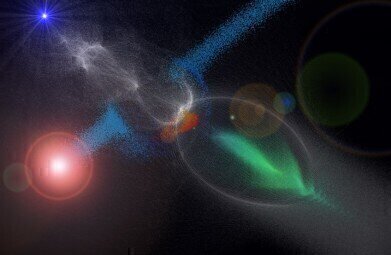-
 Illustration, based on simulations, of the Trojan horse technique for the production of high-energy electron beams. A laser beam (red, at left) strips electrons (blue dots) off of helium atoms. Some of the freed electrons (red dots) get accelerated inside a plasma bubble (white elliptical shape) created by an electron beam (green). (Credit: Thomas Heinemann/University of Strathclyde)
Illustration, based on simulations, of the Trojan horse technique for the production of high-energy electron beams. A laser beam (red, at left) strips electrons (blue dots) off of helium atoms. Some of the freed electrons (red dots) get accelerated inside a plasma bubble (white elliptical shape) created by an electron beam (green). (Credit: Thomas Heinemann/University of Strathclyde)
News & Views
Project could Inspire Next Generation X-ray Lasers and Particle Accelerators
Oct 02 2019
A ground breaking technique that could produce an electron beam up to 10,000 times brighter than the most powerful beams today, has been developed by researchers from the UK and US. The findings* could be particularly applicable for use in the next generation of more compact, more powerful particle accelerators, enhancing scientific applications.
Led by the University of Strathclyde’s Professor Bernhard Hidding, who is also a member of the STFC’s Cockcroft Institute, the E-21-: Trojan Horse experiment which was carried out at the U.S Department of Energy’s Stanford Linear Accelerator Center (SLAC) in California, involved releasing electrons from neutral atoms inside plasma, to produce a potentially much brighter, plasma-based electron source. Professor Hidding said: “Our experiment demonstrates the feasibility of one of the most promising methods for future electron sources and could push the boundaries of today’s technology by orders of magnitude.”
The researchers also developed several auxiliary techniques, which would improve the quality and stability of their output beams and to harness the technique for applications.
In a forward-looking, complementary project funded by STFC, Professor Hidding and colleagues from UK and US are already exploring the benefits to be expected from ultrabright and ultrashort electron beams for X-ray free electron lasers and other light sources at CLARA, a particle accelerator designed to develop, test and advance new technologies for the next generation of particle accelerators and free-electron-lasers, at STFC’s Daresbury Laboratory. In conjunction with further R&D at SLAC’s FACET-II facility, the Scottish Centre for the Application of Plasma-based Accelerators (SCAPA) and the Central Laser Facility (CLF), these ultrabright beams may eventually allow production of X-ray pulses short and bright enough to allow observation of electronic motion inside atoms and molecules on their natural timescale.
Fuller details can be found at www.strath.ac.uk
*Published in Nature Physics
Digital Edition
Lab Asia 31.2 April 2024
April 2024
In This Edition Chromatography Articles - Approaches to troubleshooting an SPE method for the analysis of oligonucleotides (pt i) - High-precision liquid flow processes demand full fluidic c...
View all digital editions
Events
Apr 28 2024 Montreal, Quebec, Canada
May 05 2024 Seville, Spain
InformEx Zone at CPhl North America
May 07 2024 Pennsylvania, PA, USA
May 14 2024 Oklahoma City, OK, USA
May 15 2024 Birmingham, UK

















